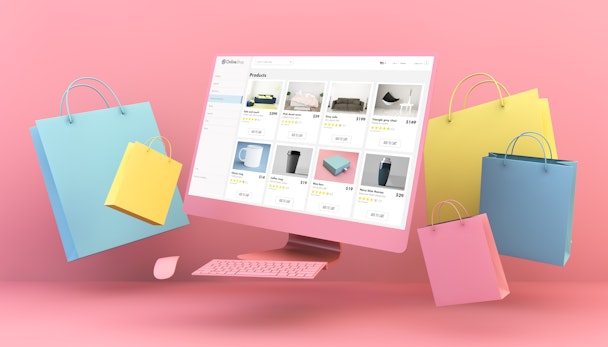The top three retail and e-commerce trends set to shape 2023
E-commerce sales are down, a lot, while shopping behaviors continue to shift. For The Drum’s Evolution of E-commerce Deep Dive, experts explain how the space will evolve further this coming year.

Inflation will compel consumers to research more and spend less, according to experts / Adobe Stock
The Covid-19 pandemic saw e-commerce growth spike, big time, but myriad issues have since created a historic drop in digital sales.
Obviously, consumers have been returning to brick-and-mortar stores – albeit not at the pre-pandemic levels. But there are other significant factors at play, including supply chain issues, low consumer sentiment and rising inflation.
The end result? A forecasted $95bn less in e-commerce sales in 2022 compared with last year, according to the Economic Times. This is after e-commerce soared at least 20% every year between 2010 and 2020, per eMarketer.
So, what’s next? Experts have identified three trends that will shape the landscape over the next year.
Advertisement
1. E-commerce and in-store shopping will have divergent roles in consumers’ lives
Yes, many shoppers around the world were eager to leave the house and return to the stores, but their behaviors have changed. Online and in-store shopping have come to serve distinct purposes for shoppers and that trend will only continue.
“Globally, we continue to see in-store shopping occur with consumers,” says Jacquelyn Baker, chief commerce experience officer at VMLY&R Commerce. “However, the role of the store has changed for shoppers. Consumers can have whatever they want, when they want, on-demand, digitally. For purchases beyond everyday essentials, meanwhile, the store serves more as a showroom for inspiration and ‘retailtainment’. Physical stores play a tactile purpose for consumers to immerse themselves in brands and experiences that ignite the senses and bring joy.”
Advertisement
While stores can offer their own speed and convenience, they are often relied upon for surprise, says Piers Fawkes, founder and president of the retail consultancy PSFK.
“Online has become a place of specificity and efficiency and real-world retail, discovery and delight. As a result, shoppers expect e-retailers to provide a sophisticated, personalized shopping experience. In contrast, personalization is not as big a deal offline. People already understand a store’s offerings and they go there for surprise and serendipity.”
2. Inflation will make consumers research more and spend less
Inflation is on the rise globally. In the US, for example, the Labor Department reported that inflation rose 8.3% since last August, which was worse than economic forecasts. This has already impacted overall consumer sentiment and most likely will affect their spending habits in the future. “Inflation concerns are very real,” adds Baker. “Currency has to stretch much further than it used to and that will continue into the next two years.”
The direct result will be a greater emphasis on researching everything in order to make an informed decision. “Brands that emphasize their marketing investments on searchable content that demonstrates consumer value will prevail,” says Baker.
At the same time, stores will benefit as they become hypersensitive to the added expense of digital fulfillment – such as rising shipping costs and delivery fees, says Baker. “The ancillary expenses of convenience will become cost prohibitive to some consumers or will be deemed unnecessary to others as they work to stretch their money further.”
Suggested newsletters for you
Overall, brands and marketers should pull all the data they can from 2008-2010, advises William Margaritis, senior vice-president of digital and e-commerce at Reprise Digital. “What did consumers do then? How did they react? How did your brand react? What worked? What didn’t?
“What we are about to see will be similar. Large purchases will be put on hold while small luxuries will be seen as economic ways to splurge. 2008 was fantastic for drugstore cosmetics brands, upscale snacks and any other daily luxury that won’t break the bank. 2023 will likely repeat that.”
3. Live and social shopping becomes a bigger part of the mix
Still, the momentum for online purchases is unstoppable. However, the way consumers buy digitally will continue to evolve, quickly. For example, livestream shopping is picking up speed.
“Social shopping is becoming more prevalent and can be done on various platforms – such as Amazon Live, TikTok Shop/Live, Instagram Live and Twitch – and also on a brand’s own website,” says Travis Johnson, global chief executive officer of Podean.
“Brands should think about what their approach is – do they have spokespeople?Do they have great locations to stream from? What products would they sell? How would they use the content after the stream has ended?”
This trend represents a shift in control for brands. “Younger generations find authenticity and trust in different places than older generations,” says Margaritis. “Predominantly, they trust their peers and they trust influencers. As brands reduce spend and are less present in the shopping conversation, peers and influencers will rise...
“Social commerce and live commerce have already become regular means of shopping in Asia and are rising rapidly in Latin America. The US and Europe won’t be far behind.”
For more on the Evolution of E-commerce, check out The Drum’s latest Deep Dive.

